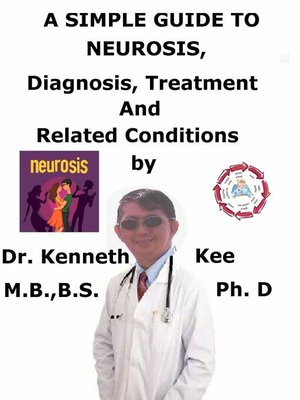
Sign up to save your library
With an OverDrive account, you can save your favorite libraries for at-a-glance information about availability. Find out more about OverDrive accounts.
Find this title in Libby, the library reading app by OverDrive.



Search for a digital library with this title
Title found at these libraries:
| Library Name | Distance |
|---|---|
| Loading... |
This book describes Neurosis, Diagnosis and Treatment and Related Diseases
There was a time when the psychiatric world recognize 2 main illness: neurosis and psychosis
Since 1980 Neurosis has been removed as a single disorder by the Diagnostic and Statistical Manual of Mental Disorders (DSM III) and placed together with other anxiety disorders.
It is still utilized in the ICD-10 F48.9 (Non-psychotic mental disorder, unspecified)
Neurosis is a disorder where negative or obsessive thoughts tend to dominate the mind, causing the behavior to be drastic and irrational, and causing the patient to struggle with daily mental changes.
Neurosis should not be mistaken for psychosis, which indicates a loss of touch with reality.
It should not be mistaken for neuroticism, a fundamental personality trait indicated in the Big Five personality traits theory.
Neurosis may also be called neurotic behavior.
Neurosis is a term that describes ic attack.
The patient will get a different definition of neurosis symptoms depending on which doctor the patient researches.
However, they all share similar features.
Sigmund Freud, the founder of psychoanalysis, formulated 3 causes for neurosis.
1. Repressed emotional trauma.
2. Sexual trauma
3. Repressed sexual libido.
Freud believed that neurosis is a coping mechanism (as example a dog attack in earlier life leading to a phobia of dogs in adulthood).
Carl Jung believed neurosis was due to a conflict between the conscious and unconscious mind.
When a person is not able to live up to their higher self, this would remain in their unconscious mind and ultimately develop as a neurosis.
This was suggested as a good thing as it permitted people to reach their potential.
Hans Jurgen Eysenck believed that a person was more likely to develop a neurosis if they shared certain personality traits, such as introversion and extroversion.
These personality traits have a biological root and are all connected to the autonomic nervous system (ANS).
People who have an ANS that responds quickly to stress will be neurotic.
Neurosis is no longer regarded as a medical disorder but comes under an anxiety spectrum.
Diagnostic principles in the Diagnostic and Statistical Manual of Mental Disorders (DSM-V) are:
1. Extreme anxiety and worry for at least six months
2. Difficulty regulating the worrying.
The anxiety is related with 3 or more of these symptoms for at least 6 months:
1. Restlessness, feeling keyed up or on edge
2. Being easily fatigued
3. Difficulty in concentration or mind becoming blank, irritability
4. Muscle tension
5. Sleep disturbance
6. Irritability
7. The anxiety causes considerable distress or impairment in social and occupational areas
8. The anxiety is not due to any physical cause
The symptoms of neurosis can be:
1. Anger,
2. Aggressiveness,
3. Anxiety,
4. Cynicism,
5. Compulsive acts,
6. Cognitive problems,
7. Disturbing thoughts,
8. Dependency,
9. Habitual fantasizing,
10. Irritability,
11. Impulsiveness,
12. Lethargy,
13. Low sense of self-worth,
14. Mental confusion,
15. Negativity,
16. Obsession,
17. Perfectionism,
18. Phobic avoidance,
19. Vigilance,
20. Unpleasant or disturbing thoughts,
21. Repetition of thoughts.
Neurosis may be treated using:
1. Behavior modification therapies,
2. Pharmacological treatments
TABLE OF CONTENT
Introduction
Chapter 1 Neurosis
Chapter 2 Causes
Chapter 3 Symptoms
Chapter 4...







